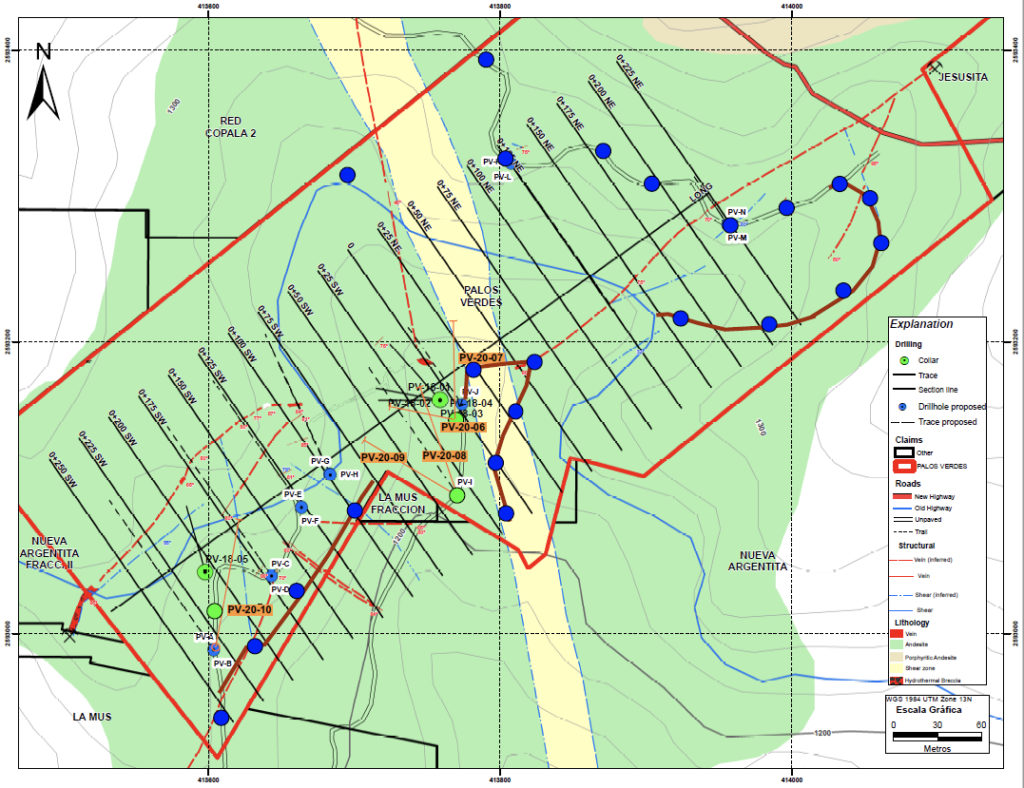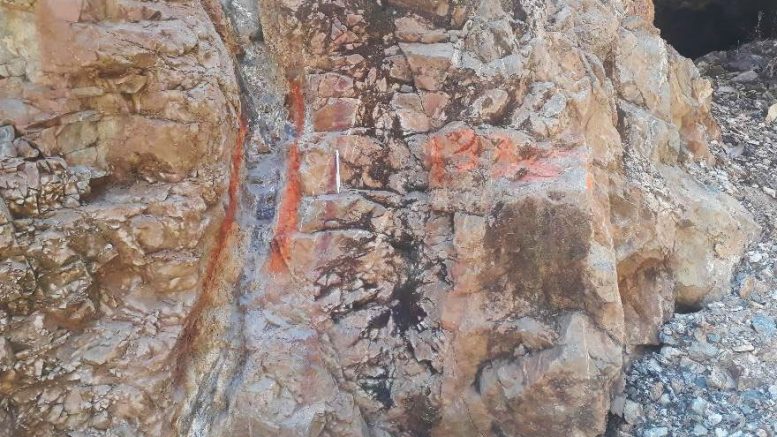Prismo Metals (CSE: PRIZ) is preparing to drill-test an important near-surface target at its flagship Palos Verdes gold project in Sinaloa state, Mexico, after receiving an extension to its environmental permit in late July.
The drill program is designed to test the Palos Verdes vein and a structural intersection with a second vein at depths where the company believes it can test a prominent, higher-grade ore shoot that holds resource potential. That exploration would be similar to the drilling accomplished by Vizsla Silver Corp. (TSXV: VZLA) on its adjacent land package (see Vizsla’s latest results here), president and CEO Craig Gibson tells The Northern Miner in an interview.
Drilling at Vizsla’s Panuco project has yielded high grades over broad intervals near the surface, with intercepts grading over 1,000 grams silver-equivalent per tonne.
Heartened by the exploration momentum next door, Prismo plans to undertake at least 2,000 meters of drilling this summer to follow up on previous shallow drill results that had intersected high-grade mineralization. The best intercept entails 2,336 grams silver per tonne and 8.42 grams gold per tonne over an actual width estimated at 0.8 meters within a larger mineralized interval with 1,098 grams silver per tonne and 3.75 grams gold per tonne over a true width of 2.3 meters.
Special advisor to the company is globally acclaimed geologist Dr. Peter Megaw, best known as co-founder of MAG Silver Corp. (TSX: MAG) and Minaurum Gold Inc. (TSXV: MGG). Megaw and his team are credited with MAG Silver’s Juanicipio discovery in the famous Fresnillo District, and Excellon Resources’s (TSX: EXN) Platosa mine, Mexico’s highest-grade primary silver mine.
Megaw received his doctorate from the University of Arizona and has more than 35 years of experience exploring for silver and gold in Mexico.
“It is an important distinction to make that Palos Verdes is not a ’close-ology‘ play to Vizsla, but we were in the area first,” noted Megaw.
“The Palos Verdes discovery was made after our geologists discovered artisanal miners were pulling native gold from an area in the middle of the company’s landholdings. Here an erosional window into older rocks is exposing high-grade mineralization,” he explained.
According to Megaw, the team has uncovered three main structural directions, peering into this ‘window’ down into the older rocks. “It entails a significant portion of the larger-scale concept that has evolved here because they’re mineralized quartz veins, but we don’t think they’re just sort of classic Sierra Madre-style epithermal veins. We think they’re related to a larger style of a gold system more characteristic of northwestern Sonora,” said Megaw.
Sonora is important because this is where key mines such as Fresnillo’s (LSE: FRES) La Herradura and Noche Buena mines are located – big dispersed, structurally controlled gold systems hosted in lower Paleozoic and Precambrian rocks, according to Megaw.
Megaw explained that these rocks form a powerful structural trend that continues southeast towards Hermosillo and then disappears under younger rocks. “Our geologist Jorge Rafael Gallardo-Romero, who has a lot of experience in northwestern Sonora, recognized the same rocks coming back to surface in the Los Pavitos area.”
Megaw noted that rocks, where artisanal miners were finding native gold in northwestern Sinaloa, had the same structural environment and alteration, suggesting a continuation of that gold belt.
“So, the target style here is not simply a narrow epithermal gold vein. It is a gold vein associated with one of these big structurally controlled northwestern Sonora-style deposits. It’s an orogenic gold belt that appears to return to the surface.”
Summer exploration
Palos Verdes is an intermediate-stage exploration project located about 65 km northeast of the tourist destination Mazatlán.
It has access to high-quality infrastructure via the interstate highway from Mazatlán to Durango, near the village of Santa Lucía.
The property comprises 22.7 hectares over one concession within the Pánuco-Copala mining district, a historically significant mining area. The district is known for precious and base-metal-bearing epithermal veins.
Gibson says Prismo leverages decades of Mexico exploration experience from two of Mexico’s successful geological exploration groups, including ProDeMin (Newstrike Capital and the Ana Paula discovery) and Minera Cascabel (MAG Silver and the Juanicipio project).
Previously, all five of the company’s holes cut mineralized veins ranging from weakly anomalous to the best hole (PV-06), which cut vein breccia and stockwork over 3.2 metres (estimated true width) grading 69 grams silver per tonne and 0.13 gram gold per tonne, and negligible base metals. The hole also returned a 0.5-metre sulphide-rich zone grading 315 grams gold per tonne silver and 0.46 gram gold per tonne, with insignificant base metals.

According to Gibson, drilling in the Palos Verdes vein has been very shallow. Using results received to date, combined with older data, Prismo has revealed the variability of width and grade expected in this district’s top veins.
“This supports our interpretation that we are well above any coherent Bonanza-grade zones in the system, and we are very eager to trace the Palos Verdes vein to greater depths and along strike. We are also pleased to have confirmed the suspected Northwest vein and look forward to including it in our next campaign as we trace both veins to depth, hopefully into more consistent widths and grades,” he said.
Drilling this summer involves eight to 10 HQ-diameter core holes over a minimum of 2,000 metres to test the veins below the previous drilling. The drills will also test the vein along strike and, importantly, explore the emerging Northwest vein, which intersects with the Palos Verdes vein on the concession.
Los Pavitos
Prismo also has an earlier-stage exploration project called Los Pavitos in the Álamos area of Sonora state.
The project consists of one concession, Los Pavitos Reducción, that covers 52.9 sq. kilometres. The concession is located on the paved highway between Navajoa and Álamos at about the 17 km. marker, and the main mineralized area is about 6 km north of the highway accessible by unmaintained dirt roads.
Mineralization at Los Pavitos comprises quartz veins and stockworks hosted in metasediments, in shear zones and parallel to foliation and crossing foliation, says Megaw.
To date, the company has traced three mineralized trends despite the limited exploration carried out. Two trends, the NE Santa Cruz trend and the NW Las Auras trend, intersect in an area of small mines and prospects on the internal concessions and extend onto the Los Pavitos concession.
Prismo has just completed a LiDAR scan on the property and is collating and analyzing the data, with a view to drill-testing priority targets stemming from this work by the fall.

Previous work has returned rock samples with as much as 40.9 grams gold per tonne and 99 grams silver per tonne over 0.3 metres. Many samples have returned between 1 and 6 grams gold per tonne and between 3 and 60 grams silver per tonne.
Prismo is tightly held by insiders, with about 32.4 million shares outstanding on a fully diluted basis.
Its shares have gained more than 70% over the past three months, but at 23.5¢ apiece, it still is trending 14.5% below its year-earlier level. The company has a market capitalization of $4.98 million.


Be the first to comment on "Prismo prepares to drill-test Palos Verdes near-surface high-grade shoot"